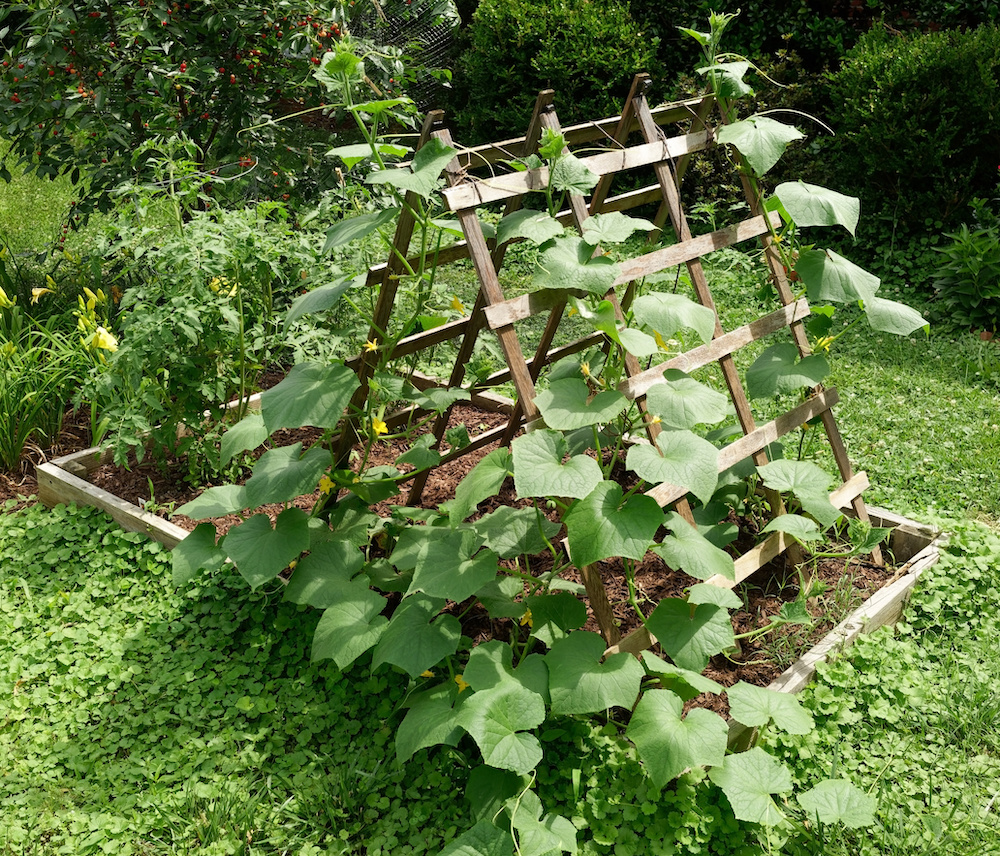There is a lot of controversy on the best way to trellis. There are so many different ways to trellis plants and a lot of it has to do with what resources you have access to.
But often, people build trellises that are cumbersome and heavy and only accommodate one crop (like the cucumber trellis below. And often the trellis will fall apart after just a season or two. If you want a simple, long-lasting, lightweight trellis system that can be used for a variety of crops season after season, then keep reading because we’ve got a fabulous solution for you to build a versatile inexpensive garden trellis. But first, if you’re new to growing, you’ll want to know why growers trellis and when you need to trellis your crops. Check out our blog on The Importance of a Versatile Garden Trellis System.

The Simple, Versatile Trellis
A good trellis should be easy to manage while still holding up those heavy plants. A good trellis system will be versatile and enable you to use the trellis for various crops. Whether you want to use a Florida weave, a net, or string train with rollers, this trellis system can be adapted to whatever crops you’re growing.
So what do you need for building this trellis system?
Materials
2×4’s
Nails or Screws
Lightweight trellis material
Step 1: Attach posts to the edge of each garden bed. For raised beds this is simple.
For in-ground beds, you may need to get creative to ensure the trellis posts stay vertical under the heavy weight of the plants. This might look like drilling a hole in a 2×4 and inserting it over rebar (like a dowel).
Alternatively, you could use heavy duty T-posts so long as you secured them in the ground enough to ensure they would not lean. Ultimately, you want two strong posts on either side of the bed. If your beds are really long, you may need posts in between for extra support.
Step 2: Place nails or screws down the posts.
Step 3: Attach your trellis material.
Here’s a video where you can see the trellis system and how you might use it across multiple beds. Oh, and cleaning this trellis system for next season? Super Easy! Check it out at the video below!
PRO TIP: Polypropylene twine does less damage to plants than the natural twine, so if you’re new to gardening, it might help to start with the polypropylene material for your trellis for the first few seasons while you get the hang of trellising.
Get Horticulture Netting![]()















Great simple trellis instruction. Thank you!
Great idea! Thank you so much. Simple and versatile. Also I like that you can shake out the dead stuff into the compost.
Is this better than two pallets?
if so, why?
Wow! This is such great info! I have been struggling with squash vines and this is the answer from now on. Will get the boards installed on each end of my boxes so all future plants! Thank you!
Great and creative, maximizing space!
I love your ideas, Stacey! Most inspiring, encouraging and informative! I bought some netting at a garage sale, but now, because of your video, now I know how to use it.
Great big thanks, and many blessings!